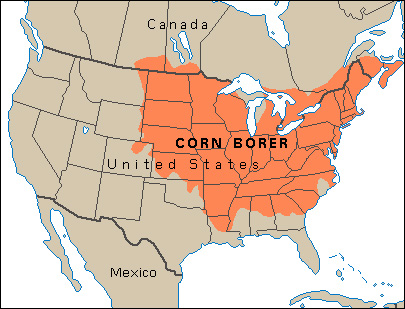Corn borer, also called the European corn borer, is a serious insect menace to corn crops. The borer is the larva of a night-flying moth. The larva is pinkish with small brown spots. The female moths begin to lay eggs on corn leaves in early June. The tiny borers feed on the young leaves and tassels. As they grow larger, they feed on the stems and ears. One or more generations of borers appear each year, depending on the length of the growing season. In winter, the larvae live in old corncobs, stems, and stubble. The corn borer eats chiefly corn and sorghum. But it attacks other plants, including celery, potatoes, beans, flowers, and weeds.

Farmers destroy corn borers during the winter by feeding cornstalks to livestock, or by shredding or burning the stalks. They plant late in the season to avoid the first flight of the moths, and use hybrid corn plants that are not affected by the corn borer. In some cases, farmers use insecticides.
